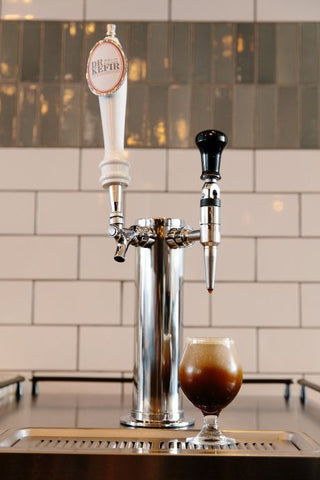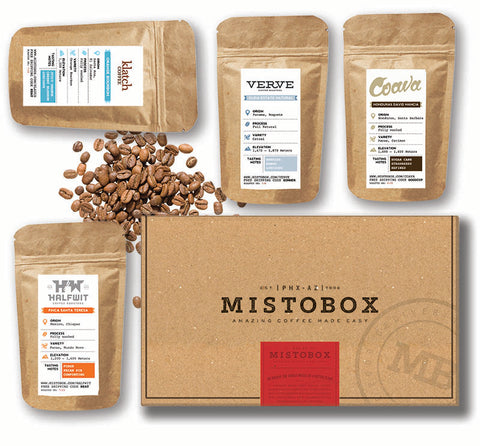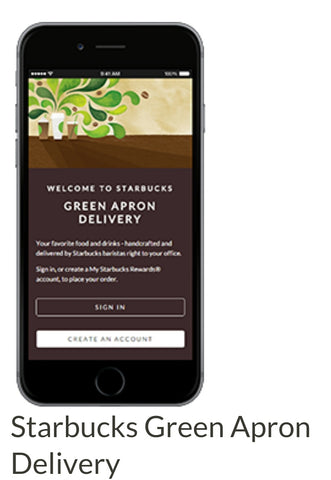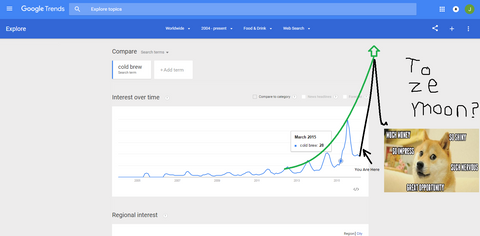Here are my picks for coffee trends of 2016, starting with #10...
10. QUALITY AUTOMATION
Automation is no stranger to coffee; most of us use automatic coffee brewers at home or pick up a cup of batch brewed coffee from the local shop. These options, while not on the cutting edge, do produce an acceptable cup of coffee. However, the past few years, there have been developments in automatic coffee brewing that have been both timesaving conveniences and produce better coffee.
BKON
Originally designed for use with tea, the BKON brewer is finally being marketed as a coffee brewer. It uses a trademarked process called RAIN, ReverseAtmospheric INfusion, to brew coffee using water maintained at a specific temperature and vacuum cycles to make the grounds more easily permeable.

HAL here made some top notch tea, let's see what he does with coffee.
In theory, this should make the coffee more soluble at lower water temperatures, allowing for a gentler extraction where more nuanced flavors can shine through. I like this feature because it may bypass the challenges of proper extraction from light roasted coffees. Additionally, the BKON allows you to set specific profiles for individual coffees, customizing brewing time, temperature and vacuum strength. Combined with the BKON Craft Cloud, their “social network” of downloadable/sharable recipes, this might be the first coffee brewer to take advantage of the internet’s network effect to radically improve coffee quality.
However, at $13,000 each, independent cafes won’t be chomping at the bit to buy one. Also, during my time as barista trainer for Metropolis Coffee, I had the opportunity to work with the BKON during its beta. At that point it was just used for tea, the tea it made was extraordinary. However, the machine had two major flaws, it was inconvenient to clean and it was constantly out of order; which lead to us calling it the “BROKON.” We gave the manufacturer a ton of data on this and hopefully the latest generation of brewers has improved upon these flaws, since at its core it is a great concept.
*Prediction Peet’s Coffee will purchase the rights or license to BKON in 2016/17 giving it the scale needed to take advantage of its network feature. Having recently acquired Stumptown and Intelligentsia coffee, Peet’s now commands a huge variety of specialty beans that are perfect for the BKON. This move might also be a crushing answer to Starbuck’s Clover and La Colombe’s Steampunk campaigns.*
Gravitech
Gravitech is the tradename for the gravimetric technology used on the Victoria Arduino Black Eagle, which is currently the "Baddest Espresso Machine on the Planet". Gravitech uses a built in scales to measure espresso yield in real time, achieving consistent extraction ratios based on the parameters set by the barista.

Hey sexy... *whistles*
This technology is the rising tide that will raise all ships in the world of espresso. Below average baristas will be able to pull above average shots consistently and above average baristas will be able to push the envelope and experiment with a multitude of brewing recipes. Not to mention, this technology will allow for less waste when cafes dial in their grinders. I haven't yet had the opportunity to work with the Black Eagle, but I've heard nothing but rave reviews. I expect 2016 to be a year where gravitech-like technologies become a hot topic in the specialty coffee world, and analogous technologies will emerge for other styles of coffee. Currently the price point of these types of machines is too high; but as the discussion begins demand should increase, which should drive competition up and prices down.
It's only going get better from here (that's typically how countdowns work).
9. COFFEE TISANES AND FLOURS
Cascara, or coffee husk, is the natural byproduct of wet processing coffee. With notes of hibiscus, rosehip, tamarind and Ancho chili, its use in tisanes is said to predate the actual roasting of coffee seeds for drinking. Cascara has been gaining traction in the US for at least 4 years now, and I feel that the market is mature enough for it to become a staple in the specialty scene. I see cascara as the go-to ingredient for cafes that want to do signature carbonated beverages, for which regular coffee is not suited.

Cascara is packed with caffeine too.
Coffee Flour
Depending on who you ask coffee flour can be made with dried coffee pulp, aka cascara, or with very lightly roasted (but still green) coffee beans. The former is said to have dried fruit notes, which is appropriate since it’s made from dried fruit; the latter is described as being nutty. Either way, coffee flour is already being called the next superfood and might contribute to the more faddish elements of the gluten free movement. With that said, I am concerned about the caffeine content of these flours and whether it is advisable to use them as the sole substitute for flour in a recipe. I could see someone eating a slice of coffee flour pound cake and having an experience similar to this cop.

Coffee Blossom Tisane
These short-lived flowers blossom right before a coffee plant begins to bear fruit. They are said to taste and smell similar to jasmine, and if coffee blossom tisanes ever take off, which they will, it will add an entirely new dimension to the origin and varietal game. I can only imagine how much people are going to be paying for Geisha blossoms…

8. NICHE COFFEE PRODUCTS
The internet has had a revolutionary effect on the variety of coffee products available today. The vast majority of these products are design based changes; for example, this spider shaped Chemex pourover contraption.

Sure it looks cool, but what does it do differently? Wait...it costs $700?! So unlike your normal $40 Chemex brewer, this one holds your spot in the breadline for you.
While plenty of people like to gush over these types of products, in my opinion, they offer only aesthetic value. There are however, emerging coffee products that offer new and unique experiences. Here are some that stood out to me.
Vega Coffee
Vega offers coffees picked, processed, roasted and packed all by the coffee farmer. Calling themselves the “Etsy of Coffee,” Vega is one of the emerging companies participating in the bean-to-cup movement and supporting women coffee farmers.

Jiva Cubes
Jiva cubes are a new take on instant coffee. These freeze dried cubes can be added to hot (or cold?) water to make coffee wherever you are. While I don't think Jiva cubes are personally for me, there are people out there that would appreciate this product; the instant coffee market needs love too.

Rafino
Rafino is a coffee grounds sieving/refining device. I really like this product because it doesn't dumb it down for the consumer, a trend that is far too common. Grind particle size distribution is one of the top five challenges being addressed currently in high-level professional coffee. And this product allows the everyday consumer to participate in the discussion. The Rafino is also in the middle of its Kickstarter funding, with $24,048 of $41,390 pledged and 24 days remaining (As of 3/21/16).

Rafino ended up raising CA$158,368! People really wanted to see this one come to life!
7. COFFEE PROSUMERS
2016 is going to be a great year for coffee related content by people like me and you. The maturation of social media has allowed all of us to have discussions with people who share our interests; and there are a lot of people interested in coffee. As we share our recipes, routines and ask questions, we give the people around us the tools to make their coffee the way they want. Enjoy this short video of me making one of my favorite drinks, the Teddy Graham Latte
Click the photo to link.
6. COFFEE COCKTAILS
The third wave has demonstrated just how deep the coffee rabbit hole really is. There are so many variables being taken into account that were NEVER taken into consideration before. When Starbucks first appeared hardly any consumers were even talking about single origin. Now, people are interested in having a deep understanding of the coffee they drink. They want to know about:
Country of Origin
Farm of Origin
Microlot
Altitude
Soil composition
Cultivar/Varietal
Processing
Roasting
Method of Production...
This attention to detail reminds me of what happened with craft beer and spirits in the early 2000's. All of a sudden there were beer companies dedicated to sourcing rare hops and whiskey companies experimenting with wine barrel aging. The same thing is happening in coffee now. Some companies, like Dark Matter Coffee, are outright aging their green coffee beans in whiskey barrels,while others, like Portola Coffee Roasters, are experimenting with a non-alcoholic cocktail bar. It's only a matter of time before they start offering the full monty; afterall, what's a more natural marriage than coffee & booze?

As of yet, I haven’t been able to find a single authoritative book dedicated to combining coffee with alcohol, but the writing is on the wall. And in my opinion, cold brew will be the linchpin. Cold brew is the most consistent way to add coffee flavor to a cocktail without adversely affecting drink temperature, dilution and clarity, the fundamental pillars of cocktail building. As you can see, I'll be contributing to this movement.
5. KEURIG WILL CONTINUE THEIR DOWNWARD SPIRAL...OR PIVOT
It seems like Keurig, makers of the famed K-Cup, have a problem. Their sales have been declining quarter after quarter for the past year. Most sources say this is due to environmental concerns about the MASSIVE amount of waste produced by K-Cups (I don’t buy this). Others cite consumer complaints about the Keurig 2.0’s feature which blocks the use of off-label pods as cause (bingo). Not to mention Keurig raised the price of their branded cups by 9% after releasing the 2.0; again ticking off a lot of people. In response to this one company released a product called The Freedom Clip. It is an attachable hardware mod that tricks the 2.0 into brewing off label pods. This allows consumers to use cheaper 3rd party pods in their brewers.

The Keurig business model was predicated on planned obsolescence and charging ridiculous sums for their coffee. K-Cups actually contain far fewer grounds than you would normally use to brew. K-Cup consumers think they’re getting a bargain but they are paying at least $25 per pound for coffee that would retail at $5-6 per pound. Top shelf single origin hipster coffee is cheaper than that. If only people knew about this robbery.
4. WATER
If you Google “Coffee Trends for 2016” you’ll notice that nearly all of the lists talk about water. They usually state something like this: “A cup of coffee is 98% water, so clearly it’s important to use high quality water”. This logically doesn’t make any sense to me. The “2%” (it’s not usually 2% BTW) is responsible for all of the coffee flavor; it’s actually a big deal too. But what is high quality water anyway? In the context of coffee, high quality water is free of odor, excess salinity and has mineral content in the proper species, range and ratio.

Water is once again a major topic thanks to the 2015 book, Water for Coffee, by Maxwell Colonna-Dashwood. In it, he explores in great depth the relationship between water composition and coffee extraction. The book, which I would only recommend for serious coffee geeks, looks at the physical and chemical processes that make your morning brew possible. His big picture ideas are the following:
· The most relevant ions that contribute to coffee extraction are calcium, magnesium and bicarbonate. These must be present in the brewing water within the spectrum of correct concentration and ratio.
· Calcium and magnesium both aid in extracting flavorful compounds from coffee grounds, primarily weak organic acids, while bicarbonate buffers the pH of the resulting extraction. Though bicarbonate acts as a base or an acid depending on the surrounding ions, in the context of coffee it generally acts as a base to buffer the weak acids that are extracted from the grounds. Thus, the following flavor relationships exist:
o Too much Ca , Mg -> Heavy, dense coffee (High extraction of flavor compounds, including undesirable ones)
o Too little Ca, Mg -> Empty, hollow coffee (Low extraction of desired flavor compounds)
o Too much bicarb -> Flat, chalky coffee (High buffering of acids into base conjugates)
o Too little bicarb -> Sharp, sour coffee(Low buffering of acids causing unchecked acidity)
· Darker roasted coffees are more soluble and thus require less calcium and magnesium for proper extraction, however, darker roasting results in less flavor complexity, as the molecules are broken down into simpler compounds via heat. As a result, a given water can extract “more” flavor from a darker roasted coffee but there will be “fewer” flavors present.
· Similar to how different styles of beer emerged from places with different water mineral composition, regional roasting preferences likely arose from the composition of local water. Some places have water better suited for fruity coffees while others are better suited for chocolatey coffees. Either way, roast and origin should be considered when trying to make the best use of local water.
What does this mean for me?
Armed with this information, the home brewer can now figure out specifically why their Yirgacheffe doesn’t sparkle when they make it at home, but their Brazil Fazenda Mariano is top notch. Cafes can explore origin and roast in the context of local water composition or create custom waters intended for use with a specific coffee. The answers presented by this newfound understanding of water cause us to ask more questions than we originally started with; which is the engine of progress.

3. DRAFT & NITRO COLD BREW
These two trends essentially go hand in hand and have been gaining momentum for at least the past two years. Coffee on tap, or draft coffee, refers to any coffee kegged under pressure and dispensed from a beer tap. Nitro coffee is a specific style of draft coffee that is infused with nitrogen gas to achieve a consistency similar to Guinness beer.

The tap on the left dispenses normal cold brew, while the other dispenses nitro cold brew.
Photo: Verve Coffee Roasters
The vast majority of draft coffees are nitrogen kegged. CO2 kegging makes terrible coffee. But only a Guinness-style tap will achieve the desired cascading effect. Besides having great texture, nitro coffees also taste sweeter than their flat counterparts. I’m not sure why this is the case.
Remember when I said draft coffee had to be kegged, I lied; it can also be canned (cans are just single serving kegs anyway). This year, expect to see even more canned draft coffees on the market. Since canning preserves the nitro effect, many roasters are offering them as an alternative for people who can't make it to their shops
2. DELIVERY & SUBSCRIPTION
Coffee bean subscriptions have been around for quite some time now. But for most part they have been rudimentary and one-size-fits-all. Now, there's an entire ecosystem of coffee companies offering unique products and experiences. Best of all, many of them deliver directly to your home.
Some companies offer responsive subscription models where you are first sent several coffee samples to brew. You rate the coffees and they use this information to cater later shipments to your tastes. Ideally they would send you coffees you prefer more and more over time. Some of the preferences they cater to are varietal, roast level, flavor profile, and sourcing.





